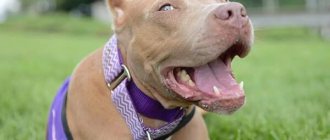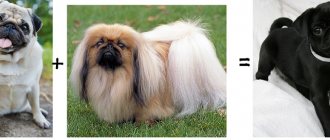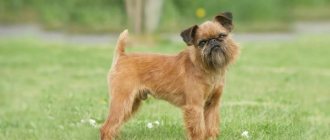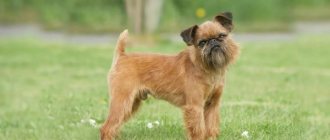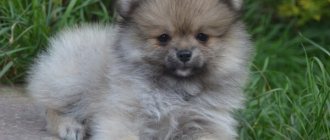Small poodles are incredibly sweet and charming dogs, which is often emphasized by their haircut in the most bizarre shapes. These dogs are ideal for living in city apartments, although they will also feel at ease in a private home.
What types of small poodles are there and which one is best to keep as a pet? This is what we will talk about today.
From the history of the appearance of the breed
The smallest poodle was bred from a large poodle, which is considered standard and is not a decorative breed, but a service and sporting breed. Unlike the royal and medium, the toy poodle is a young breed that appeared only in the 20th century. The main goals of selection when breeding it were to reduce its size as much as possible and give it a particularly decorative appearance, so that the dog would resemble a charming toy. The latest FCI standard for the breed was registered in 2007.
By the way! There is a legend that the toy poodle was brought by sailors from Asian countries, but there is no official confirmation of this.
Historical reference
Toy's ancestor is a large standard poodle, which gained popularity among nobles at the court of Queen Marie Antoinette of France.
The favorites of the aristocracy appeared as a result of crossing two breeds - the German shepherd (sheep poodle) and the Spanish (water poodle). They were initially considered hunting animals, but over time they began to spend more and more time at balls rather than in the swamps. Let us remember that the French lapdogs and papillons were also favorites of the French aristocracy.
Although the breed has not been around for very long, it has successfully passed the standardization procedure at the regional and international levels.
Description of the breed with photos
The prefix toy in the name means “toy” in English. Representatives of the breed outwardly correspond to this characteristic. The toy poodle has a proportional build, a joyful facial expression and a cheerful disposition. Sometimes the toy is called the small poodle .
- Head. The shape is correct according to the fox type. The forehead is convex, slightly oblong, of medium width. The eye arches are well developed, but do not give the muzzle a heavy appearance. The bridge of the nose is shorter than the forehead, straight. The jaws are quite strong with a full set of white teeth. Scissor bite.
- Nose. The size is proportional to the head. It looks flat from above, with a rectangular profile. The color of the lobe is black or matches the color of the coat.
- Eyes. Almond shaped. The eyelids are dense and colored. The color of the iris ranges from dark brown to golden amber. The look is interested, expressive.
- Ears. Hanging, close to the head. Rectangular shape with rounded ends. If the dog is interested in something, he lifts them slightly and turns them forward a little.
- Body. The poodle's build is correct, without unnecessary elongation. The scruff is pronounced. The withers are smoothed. The back is of medium width, tapering at the croup. The loin is pronounced. The croup is rounded. The transition line to the hip is smooth. The chest is oval in shape. The ribs are wide and springy. The front part of the sternum protrudes slightly beyond the front paws. The chest is lowered to the level of the elbow joints. The belly is tucked up, which gives the animal a sporty appearance.
- Tail. Set high, without bending. The breed standard allows for natural length or docking.
- Paws. Smooth, proportional to the body in length, with strong joints. Hips with pronounced smooth muscles, wide. The paw is collected tightly. There are small connecting membranes between the fingers. The toe pads and claws should be nose-colored or black.
Minor deviations in the appearance of a poodle from the standards are not a reason for culling, but will reduce the exhibition score. Dogs with severe defects are not allowed for exhibitions and are not recommended for breeding.
Size and weight
The weight and height of an adult dog depends on the category - toy or small toy . The first has a height at the withers of up to 28 cm , and the second does not exceed 25 cm . Poodles whose size at the withers exceeds 28 cm are classified as dwarf. The weight of the toy is from 3 to 5 kg . A small one weighs no more than 2 kg .
Coat type
The poodle's coat is curly, abundant, with fine guard hairs. It is elastic and resists compression. Less common are individuals with coarse corded hair, which is also allowed by the standard. The dog has no undercoat, as well as a dog smell. Poodles do not actively shed. They are hypoallergenic breeds.
Variety of colors
Toy poodle coat colors vary. The official breed standards have approved 6 options. Crossing dogs with different coat colors can produce puppies of unpredictable mixed colors. They are not suitable for exhibitions, but, due to their decorative nature, are very popular.
- White. Common and one of the most popular colors. This dog looks like a toy. The puppy may have a slight apricot or cream tint to the coat, which fades as it matures. A white dog's skin is pink or spotted. The nose and claws are black. The eyes are brown.
- Black. Refers to the classics. The wool should not have gray, brown, silver shades or a reddish tint. The nose, paw pads and claws are only black, without spots. Skin blue or gray.
- Chocolate (brown). The coat color is a uniform rich brown color. On the ears, the fur is slightly lighter than the base tone. The nose is brown. Eyes brown or amber.
- Silver. The coat is a smooth gray color. The adult coloration develops during the first 2-3 years of a dog's life. At birth, puppies are black. The silver color can be determined starting at 6 weeks. Nose, lips, eyelids black. Eye color is dark brown.
- Red. The main shade is mahogany (dark red). The color of the nose, eyelids and lips is brown or black.
- Apricot. Any apricot shades are acceptable. As the dog ages, it becomes lighter in color. Quite often, old dogs turn from apricot to cream. Skin color is pink, less often blue. The color of the eyelids and nose is brown or black.
Since 2007, two more color varieties have been recognized as the standard - white and black harlequin and black and tan. The second is a black poodle with small markings of any color.
A haircut
Grooming your toy poodle can be done at home. Place the dog on the table. For a dog to stand still, it must be on a leash. If this is your first haircut, show the clipper to the animal and let him sniff it. Then simply turn on the device without starting the procedure so that the dog can get used to the unfamiliar object and stop being afraid.
Head and neck haircut
- With one hand, grab the dog by the muzzle, and with the other hand, fold one ear back. While holding the dog, clip the hair with a clipper, drawing a line from the curled ear to the nose, then from the ear to the corner of the eye.
- Trim the fur on the cheek, then above the eye, under the eye.
- Lift the dog's head up and trim the hair on the neck.
- Cut the dog's hair on the other side in the same way.
Paw trimming
- Grasp the dog's paw with your left hand, with your thumb on top. Trim the fur.
- Then you need to remove it from your fingers. Make the dog bend its paw at the ankle. Trim off the fur between the fingertips.
Tail cut
- When cutting the tail, the clipper should move from its base to the end. Leave a pompom at the end of the tail.
- Trim the fur between the hind legs, first lifting the animal's tail.
Belly haircut
- Place the dog on its hind legs, holding it by its front legs. Trim it by pointing the clipper from the navel down the inner thighs to where the fur begins to thicken.
- Trim the belly, lifting the dog's paws one at a time.
Popular haircuts
To achieve a certain haircut, do not remove hair on certain parts of the body.
- "A lion". Trim the back of the body to the level of the ribs. Trim the fur on the face, tail, and paws. Leave the pom-poms on the ankles and tail.
- "Modern". Trim the hair on the face, back (from the withers), and croup. No need for paws. Hair of 1 cm in length is left on the belly and sides.
- "Bikini". The dog should have short hair all over its body. Pompoms are left on the ankles and the tip of the tail.
Health and illness
Small breed dogs often suffer from diseases. The toy poodle is most susceptible to several pathologies.
- Fusion of the nasal passages. The defect is congenital. The dog has severe snoring and difficulty breathing. Treatment is surgical.
- Pathologies of the cardiovascular system. To reduce the risk of disease, your pet should be protected from stress and not subjected to physical exertion.
- Eye diseases. The most common group of diseases found in poodles of various varieties. Most often, dogs are diagnosed with conjunctivitis, cataracts, glaucoma, retinal atrophy, and entropion. Almost all diseases have a genetic predisposition, and their treatment is of little effectiveness. It is not uncommon for older poodles to have poor vision or become completely blind.
- Epilepsy. It is usually diagnosed in puppies and can either progress or go into a state of stable remission throughout life. The pathology is hereditary in nature, which is mainly associated with the high nervous excitability of the animal.
- Diabetes. The pancreas of all toy dogs is quite weak. Genetic predisposition plays the main role here. Eating disorders significantly increase the risk of developing the disease. Supportive therapy was adopted.
- Diseases of the mouth. Toy poodles often suffer from gingivitis and ulcerative stomatitis as they age. The main causes of these diseases are poor nutrition and insufficient oral care. Regular tartar removal, a balanced diet and preventative visits to the veterinarian will help avoid problems.
- Otitis. The disease is mainly related to the shape of the ears. Long and hanging, they do not allow the internal funnels to be fully ventilated, and if water gets into them, they prevent it from flowing out. The dog easily develops inflammation (purulent or non-purulent). The main preventative measure against otitis media is proper ear hygiene.
- Urolithiasis disease. Metabolic disorders are common to all dwarf dogs. They cause the accumulation of salts and improper removal from the body, causing the appearance of stones in the kidneys, ureter and bladder.
Small breeds are highly susceptible to viral pathologies, which is why strict adherence to the vaccination schedule and the quarantine period after them is necessary. During the first 12 months of life, the puppy receives 3 vaccinations, then vaccinations are given once every year.
Lifespan
Despite its delicate health, the small poodle is a long-lived dog. If the owner follows all recommendations for keeping and feeding the pet, it can live up to 16 years. It is not uncommon for a dog, if it has not suffered from viral infections, to live for 18 years. To maintain health, older poodles require a more fortified diet, and they also need to visit the veterinarian regularly (at least once every 3 months).
Character and intelligence
All poodles are highly intelligent, easy to train and can master complex tricks with interest. When living in a family, the dog quickly remembers the basic phrases of those around him and begins to understand not only commands, but also speech addressed to him.
Toy poodles have a cheerful and active character. They become very attached to their owners and require a lot of attention. These dogs do not tolerate loneliness well, which is why they cannot remain alone in an apartment for a long time without damaging their psyche. If your toy poodle is forced to be alone during the day, you should have a second pet (dog or cat) with whom he can communicate. Otherwise, you cannot have this breed.
Attitude towards children and others
Poodles willingly take part in children's games, but only if this does not cause them any unpleasant sensations. When children try to force a dog to communicate, it may display its hunting nature and use its teeth. Because of this, adults should explain to the child that the poodle is not a toy, but a full member of the family that should be taken into account.
The toy poodle behaves friendly with other pets and quickly finds a common language with them. He will willingly communicate not only with dogs close in size to him, but also with large ones, as well as cats.
The Toy Poodle is friendly towards strangers. He will willingly play with guests if they want it, but he will not impose himself. The pet is indifferent to passers-by on the streets: he does not try to get to know them and does not show aggression.
Classification of wool types
According to the type of coat, all size varieties of poodle are divided into two types:
- Curly. The thick and thin fur of these dogs curls into rather dense curls.
- Corded. This variety is characterized by dense cords made of harsh, thick wool, the length of which can reach 20 cm.
Currently, curly poodles are more popular than corded poodles, which are distinguished by their peculiar appearance, which not all lovers of the breed like. And modern haircuts look better on curly hair than on corded hair, which is why these poodles are less popular as show dogs.
Curly.
However, a corded poodle, beautifully trimmed to look like a lion, can also look very impressive and at the same time original. In any case, such a pet is guaranteed the attention of others who are interested in its unusual appearance. But in order for the cords to be correct, such a dog needs constant coat care. The corded poodle needs to be bathed regularly using shampoo for coarse coats, and every 3-4 weeks, overly large cords should be removed, unraveling them at the base.
Curly and corded.
The final formation of cords in such poodles is completed when the pet reaches 3-4 years of age.
Training and education
Due to their high natural intelligence, poodles quickly learn commands, and there are no difficulties with their upbringing and training. It is recommended to train the puppy in a playful way with classes lasting no more than 15 minutes. You can repeat lessons only several times a day. The dog's nervous system is highly sensitive, and it is unacceptable to apply harsh training and punishment to it. For each action performed, the pet should be rewarded with a treat.
First of all, your pet needs to be trained to follow the commands “come” and “fu”, as they are necessary during walks.
Important! Animals that are being prepared for exhibitions must be taught from an early age to behave calmly when examining their teeth, as well as to walk and stand correctly.
Some owners are of the opinion that a toy poodle dog does not need training. This belief is erroneous, since during a walk a pet can pick up and eat something harmful, and if it gets carried away with its own business, it may not immediately return to its owner and get lost. Also, lack of education leads to problems when traveling and when visiting the veterinarian.
Pros and cons of the breed
| Toy poodle - advantages of the breed | Toy poodle - disadvantages of the breed |
| Hypoallergenic | Increased need for attention |
| Cheerful character | Very high activity |
| High intelligence | Need to take long walks daily |
| Possibility of keeping different animals | Need for daily brushing |
| High life expectancy | Intolerance of loneliness |
| Beautiful appearance | Tendency to many diseases |
| Variety of colors |
When deciding whether to adopt a toy poodle, you should very carefully evaluate all the pros and cons of the breed, the traits and character traits of the animal that are significant in a particular case.
Dossier
Adult height: 28-38 cm. Weight: 7-8 kg. Characteristic color: coat color can be white, gray, black, apricot, brown. Coat length: long, up to 20 cm. How long does a miniature poodle live: from 12 years to 15 years. Advantages of the breed: very cheerful, playful and friendly dogs. The breed is distinguished by good trainability and high intelligence. Wool does not cause allergies. Difficulties of the breed: jealous, do not tolerate loneliness well. Average price: 150-450 US dollars. Classification: small breed, decorative, apartment, companion dog.
Care and maintenance
You can only keep a miniature poodle in an apartment. The possibility of free walking in the garden will help improve the health of the dog. Just because your pet can be litter box trained, like most toy breeds, doesn't mean it won't require walking. Every day the dog needs to be walked 2 times a day. The duration of the walk cannot be less than 1 hour.
Even a dog with a haircut should be combed once a day. They bathe the small poodle using a special shampoo for animals once every month and a half. Examination of teeth and oral cavity is carried out once a week. If damage is detected, a visit to the veterinarian is required. Nails are trimmed regularly as needed. Once a week, wipe the animal’s eyes and ears with a cotton swab. For the eyes it is soaked in calendula balm, and for the ears in antiseptic. You need to use a different swab for each ear and each eye. If purulent discharge is detected, you must immediately visit a veterinary clinic.
From the first day of life, a small poodle in the house should have its own bed, toys and dishes. For walks in rainy, damp weather, it is better to stock up on overalls.
Important! If the owner decides to take the pet to bed, then even after the first time it will be impossible to wean the poodle from sleeping together. When you don’t want to let your dog into bed all the time, you shouldn’t do it just once.
What to feed your pet
When a miniature poodle is prone to allergies, ready-made hypoallergenic food is chosen for feeding it. In other cases, natural nutrition is preferable. It should be balanced, varied and always fresh. The water in the drinking bowl must always be unboiled and clean. It should be changed at least 2 times a day. The volume of the drinking bowl needs to be at least 500 ml.
The dog's diet should consist of ½ lean meat. It is pre-scalded, and for older dogs it is boiled. You also need cereals, mainly buckwheat, rice and oatmeal, cooked in water and seasoned with vegetable oil. Lean sea fish is given only boiled and no more than 2 times a week.
Vegetables, with the exception of potatoes and legumes, fresh or steamed are required daily. Fruits are given only as a treat and are not very sweet. Egg yolk (preferably from quail eggs) is included in the diet 2 times a week in small quantities. If the dog is intolerant of fermented milk products, cottage cheese, kefir or fermented baked milk are given to the dog no more than 2 times a week. Feeding frequency for puppies and adult poodles is the same as for other breeds.
Important! It is strictly forbidden to give your pet sweets, flour, fatty foods, as well as fried, smoked and salty foods.
How to choose a puppy
When choosing a toy poodle puppy, you should carefully study the documents of its parents, ideally if they can be seen, and also examine the animal. Healthy puppies are active, have clean eyes and noses, and no traces of feces in the anal area. The puppy's fur should not be matted. Infection with fleas or worms indicates an unscrupulous breeder. The abdomen should be firm, but not bloated. Its excessive size indicates intestinal diseases or severe clay infestations. It is highly undesirable to purchase such a pet.
The Toy Poodle breed is one of the popular decorative dog breeds. Such pets, even at an advanced age, are characterized by optimism and cheerfulness. They are equally suitable for a family with children and a single person. Proper care and proper feeding will maximize the life of a miniature dog.
Which owner is it suitable for?
Poodles are active, playful and lively dogs. They require constant play, training and walks. Without an active lifestyle, dogs will become irritable and distant.
Dogs do not tolerate rude treatment and indifference. They need constant praise, care, love and affection.
The dog owner must be:
- active and mobile;
- soft;
- consistent;
- calm;
- caring.
This pet is primarily a lap companion dog.
It is not intended for home security or hunting. If you are not confident that you can provide your poodle with constant care, companionship, praise and walks, get yourself another dog, as this breed requires refined communication.
